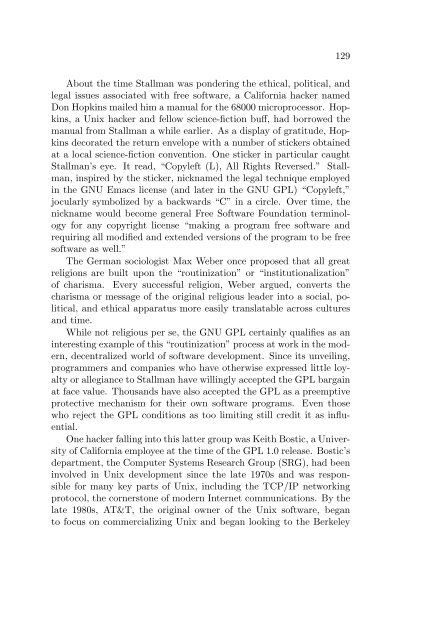Create successful ePaper yourself
Turn your PDF publications into a flip-book with our unique Google optimized e-Paper software.
129<br />
About the time Stallman was pondering the ethical, political, and<br />
legal issues associated with free software, a California hacker named<br />
Don Hopkins mailed him a manual for the 68000 microprocessor. Hopkins,<br />
a Unix hacker and fellow science-fiction buff, had borrowed the<br />
manual from Stallman a while earlier. As a display of gratitude, Hopkins<br />
decorated the return envelope with a number of stickers obtained<br />
at a local science-fiction convention. One sticker in particular caught<br />
Stallman’s eye. It read, “Copyleft (L), All Rights Reversed.” Stallman,<br />
inspired by the sticker, nicknamed the legal technique employed<br />
in the GNU Emacs license (and later in the GNU GPL) “Copyleft,”<br />
jocularly symbolized by a backwards “C” in a circle. Over time, the<br />
nickname would become general Free Software Foundation terminology<br />
for any copyright license “making a program free software and<br />
requiring all modified and extended versions of the program to be free<br />
software as well.”<br />
The German sociologist Max Weber once proposed that all great<br />
religions are built upon the “routinization” or “institutionalization”<br />
of charisma. Every successful religion, Weber argued, converts the<br />
charisma or message of the original religious leader into a social, political,<br />
and ethical apparatus more easily translatable across cultures<br />
and time.<br />
While not religious per se, the GNU GPL certainly qualifies as an<br />
interesting example of this “routinization” process at work in the modern,<br />
decentralized world of software development. Since its unveiling,<br />
programmers and companies who have otherwise expressed little loyalty<br />
or allegiance to Stallman have willingly accepted the GPL bargain<br />
at face value. Thousands have also accepted the GPL as a preemptive<br />
protective mechanism for their own software programs. Even those<br />
who reject the GPL conditions as too limiting still credit it as influential.<br />
One hacker falling into this latter group was Keith Bostic, a University<br />
of California employee at the time of the GPL 1.0 release. Bostic’s<br />
department, the Computer Systems Research Group (SRG), had been<br />
involved in Unix development since the late 1970s and was responsible<br />
for many key parts of Unix, including the TCP/IP networking<br />
protocol, the cornerstone of modern Internet communications. By the<br />
late 1980s, AT&T, the original owner of the Unix software, began<br />
to focus on commercializing Unix and began looking to the Berkeley


